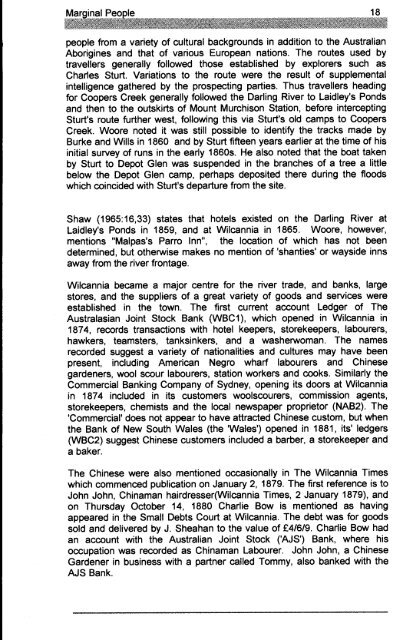Adec Preview Generated PDF File - The Sydney eScholarship ...
Adec Preview Generated PDF File - The Sydney eScholarship ...
Adec Preview Generated PDF File - The Sydney eScholarship ...
Create successful ePaper yourself
Turn your PDF publications into a flip-book with our unique Google optimized e-Paper software.
people from a variety of cultural backgrounds in addition to the Australian<br />
Aborigines and that of various European nations. <strong>The</strong> routes used by<br />
travellers generally followed those established by explorers such as<br />
Charles Sturt. Variations to the route were the result of supplemental<br />
intelligence gathered by the prospecting parties. Thus travellers heading<br />
for Coopers Creek generally followed the Darling River to Laidley's Ponds<br />
and then to the outskirts of Mount Murchison Station, before intercepting<br />
Sturt's route further west, following this via Sturt's old camps to Coopers<br />
Creek. Woore noted it was still possible to identify the tracks made by<br />
Burke and Wills in 1860 and by Sturt fifteen years earlier at the time of his<br />
initial survey of runs in the early 1860s. He also noted that the boat taken<br />
by Sturt to Depot Glen was suspended in the branches of a tree a little<br />
below the Depot Glen camp, perhaps deposited there during the floods<br />
which coincided with Sturt's departure from the site.<br />
Shaw (1965:16,33) states that hotels existed on the Darling River at<br />
Laidley's Ponds in 1859, and at Wilcannia in 1865. Woore, however,<br />
mentions "Malpas's Parro Inn", the location of which has not been<br />
determined, but otherwise makes no mention of 'shanties' or wayside inns<br />
away from the river frontage.<br />
Wilcannia became a major centre for the river trade, and banks, large<br />
stores, and the suppliers of a great variety of goods and services were<br />
established in the town. <strong>The</strong> first current account Ledger of <strong>The</strong><br />
Australasian Joint Stock Bank (WBC1), which opened in Wilcannia in<br />
1874, records transactions with hotel keepers, storekeepers, labourers,<br />
hawkers, teamsters, tanksinkers, and a washerwoman. <strong>The</strong> names<br />
recorded suggest a variety of nationalities and cultures may have been<br />
present, including American Negro wharf labourers and Chinese<br />
gardeners, wool scour labourers, station workers and cooks. Similarly the<br />
Commercial Banking Company of <strong>Sydney</strong>, opening its doors at Wilcannia<br />
in 1874 included in its customers woolscourers, commission agents,<br />
storekeepers, chemists and the local newspaper proprietor (NAB2). <strong>The</strong><br />
'Commercial' does not appear to have attracted Chinese custom, but when<br />
the Bank of New South Wales (the 'Wales') opened in 1881, its' ledgers<br />
(WBC2) suggest Chinese customers included a barber, a storekeeper and<br />
a baker.<br />
<strong>The</strong> Chinese were also mentioned occasionally in <strong>The</strong> Wilcannia Times<br />
which commenced publication on January 2, 1879. <strong>The</strong> first reference is to<br />
John John, Chinaman hairdresser(Wilcannia Times, 2 January 1879), and<br />
on Thursday October 14, 1880 Charlie Bow is mentioned as having<br />
appeared in the Small Debts Court at Wilcannia. <strong>The</strong> debt was for goods<br />
sold and delivered by J. Sheahan to the value of £4/6/9. Charlie Bow had<br />
an account with the Australian Joint Stock ('AJS') Bank, where his<br />
occupation was recorded as Chinaman Labourer. John John, a Chinese<br />
Gardener in business with a partner called Tommy, also banked with the<br />
AJS Bank.




